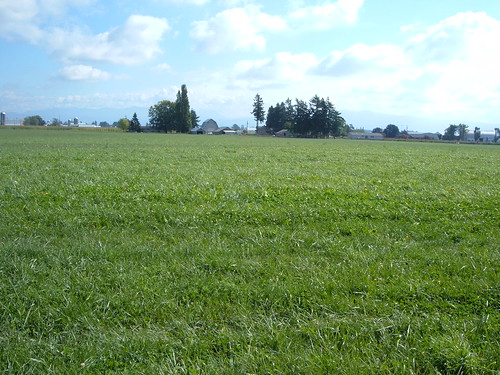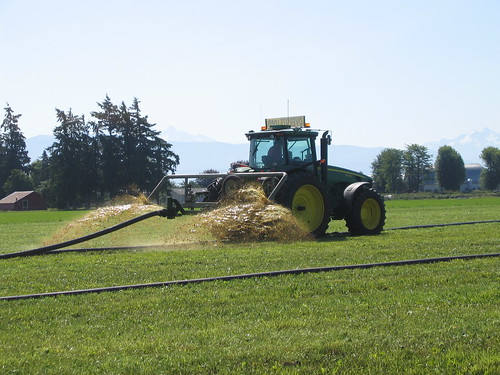 |
| Grass field in Whatcom County, site of the study |
Right off the top, we want to thank the landowner. Thanks to his hospitality, our state has some new-found science that will help both agriculture and water quality.
Why it matters
We think Washington’s agricultural industry is incredibly valuable and important to our state. We believe that livestock and agricultural production can co-exist and thrive along with clean water in our rivers and streams.However, livestock manure can be a threat to our underground water supplies. Manure contains nitrogen which converts to nitrate in the soil. When nitrate gets into drinking water, it is a health risk, especially for babies and pregnant women.
Our study
For nearly five years through 2009, this dairy landowner in Whatcom County voluntarily agreed to allow scientists Barb Carey of the Department of Ecology and Dr. Joe Harrison from Washington State University to monitor and measure the amount of manure he applied to a 22-acre grass crop field in Whatcom County.The work included measuring soil, crop, and groundwater to track where the nitrogen from the manure went.
Other partners in this work included the state departments of Agriculture and Health.
Why this location?
We selected this study location because the land sits over the Sumas-Blaine AquiferThe aquifer – an underground water supply – is the main drinking water source for 18,000 to 27,000 people in northern Whatcom County. It has some of the most widespread and elevated nitrate concentrations in the state. It is relatively shallow, making it vulnerable to pollution from activities above ground.
Over the last 30 years, 29 percent of the wells tested in the Sumas-Blaine Aquifer have failed to meet the nitrate drinking water standard at least once.
 |
| Aerator adding manure to field |
Here are some more we took during the study.
What our study found
We have shared our study findings not only with the landowner, but also with the Washington Dairy Federation, and with legislators, the Whatcom Conservation District, and other agricultural partners. We have asked others to read and weigh in on our findings – in fact that’s why it took us a while to get this report finished. Our key findings:- We found that the major source of nitrate in groundwater at the study site was from manure applied for grass production. The amount and timing of manure applied each year to the field were the overriding factors that affected nitrate levels in the shallow (less than 11 feet) groundwater. When manure was applied at the recommended amounts and times of the year, nitrate concentrations in groundwater were low enough to meet safe drinking water levels.
- Most of the annual precipitation in the area occurs during the period of limited crop growth (October through March), when rain carries available nitrate in the soil to the water table. Late fall application in 2006 followed by heavy rain resulted in a significant increase in the groundwater nitrate concentration.
- The study found that it is not possible to accurately predict actual groundwater nitrate concentrations based on the amount of nitrogen applied. Neither the post-harvest soil nitrate test nor the nitrogen mass balance methods that we evaluated was a good predictor of resulting shallow nitrate concentrations in groundwater.
- Among the report’s recommendations is continued collaboration between state and local organizations in partnership with universities, dairies, and other agricultural producers to improve the efficiency of nitrogen use and protect groundwater quality.
What our partners are saying
“This project was designed to look at how we manage the complex system of the nitrogen cycle on a farm field,” said study partner Dr. Joe Harrison of Washington State University. “It is a dynamic cycle affected by rain, temperature, tillage practices, manure application, fertilizer application, weed control, and irrigation management.”Harrison’s advice to landowners:“Keep good records of manure application rates; have your manure tested multiple times during the year; and have reliable estimates of crop yield, as well as a forage test. This data will allow one to accurately estimate the nitrogen balance on the field.”
He added that the landowner who allowed access for the study “…deserves a pat on the back for providing and creating a safe learning environment and the opportunity for the Washington dairy industry, Ecology, the Department of Agriculture, Whatcom Conservation District and WSU to collaborate on such a project. His commitment to environmental stewardship is appreciated.”
Clark Halvorson, director of the Office of Drinking Water said: “Collaborations with dairymen like this will help us identify new management practices that better protect our drinking water supplies and strengthen our vital agricultural industries.”
Added Virginia Prest, manager of the Washington State Department of Agriculture Dairy Nutrient Management Program “The majority of our state’s 400 dairies work hard to manage their manure to protect water quality in their communities. This study offers some key information that can help with that important effort.”
You can read our report “Nitrogen Dynamics at a Manured Grass Field Overlying the Sumas-Blaine Aquifer in Whatcom County" online. Follow our work with the agricultural community at Clean Water on Agricultural Lands.

No comments:
Post a Comment